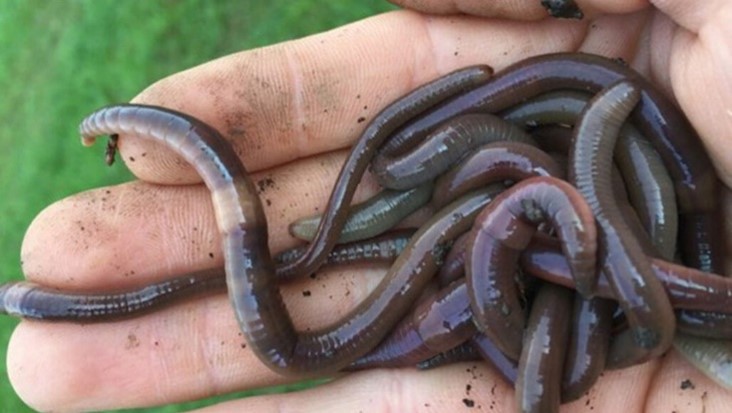Jumping worms are a group of invasive earthworm species (Amynthas spp.) that are established in Vermont and can be easily spread. Their name comes from their tendency to thrash and wriggle violently when disturbed. Jumping worms live on the soil-surface usually just under leaf litter in forests, gardens, and agricultural landscapes. They rapidly consume organic matter and excrete castings that resemble coffee grounds. The grainy worm castings can be easily washed away by rain or result in nutrient loss through leaching.  Erosion exposes tree roots and can create an understory environment that welcomes establishment of invasive plant species. The distinctive soil signature of jumping worms can also affect residential garden health and vigor.
Erosion exposes tree roots and can create an understory environment that welcomes establishment of invasive plant species. The distinctive soil signature of jumping worms can also affect residential garden health and vigor.
Jumping worms and the cocoons/egg cases can be spread through compost, leaf litter, wood chips, nursery plants, and soil. Another pathway for spread is if they are sold as fishing bait. In Vermont, adults die off at the end of the growing season and the tiny cocoons persist throughout winter. Larvae hatch as soon as the temperature rises above 50° F and can complete their life cycle in 60 days.
FAQ:
Where are jumping worms found in Vermont?
Jumping worm has been confirmed in 12 out of 14 Vermont counties, Orleans and Essex counties at this time do not have confirmed reports.
Is jumping worm under a federal quarantine?
No, not currently.
What agricultural problems do jumping worms cause?
Jumping worms can change soil composition, texture and pH, which can be harmful to plant health and vigor. Nutrient loss through erosion and leaching area also possible. Perennial landscapes and forests (including sugarbushes) appear to be most at risk of jumping worm harm. Significant damage to high tunnel vegetable production has been reported, as well.
What do jumping worms mean for vermicomposting?
Do not introduce jumping worms (Amynthas spp.) for use in vermicomposting; ensure that any composting worms are the correct species and buy from reputable dealers. Also, do not release any purchased worms, for composting (or fishing), into the environment.
What pesticides can be used to treat jumping worms?
There are no approved pesticides for jumping worms, at this time.
What is the Agency is doing?
VAAFM educates the horticultural industry and the public on how to identify jumping worms in order to decrease spread. VAAFM is also working with partners to understand possible chemical or biological treatment options and will share this information with the public.
Best management practices for preventing introduction
- Clean tools, boots and equipment if you worked in a location that may have jumping worm
- When possible, install bare root plants in garden beds.
- Purchase heat treated bagged soil, compost & wood chips/mulch or solarize by leaving in the sun for at least a week prior to use.
- Do not use jumping worms for bait, vermi-composting, or gardening
- Inspect landscape regularly and look for granular castings on the soil surface
If jumping worms are present on a property
- Do not transfer any untreated mulch, soil or plants to other locations
- Raking leaf litter/ mulch and hand-picking adults can reduce populations
- Place worms in soapy water, vinegar or alcohol to kill
- Areas may be solarized using plastic or tarps to heat the soil to at least 105°F
Additional Resources

